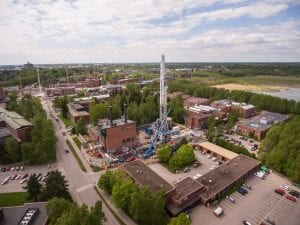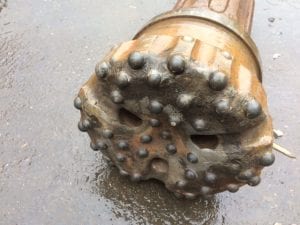By Peter Malin, SMU Adjunct Faculty
Peter Malin, an Adjunct Faculty in the SMU Huffington Department of Earth Sciences provided this update on the st1 Deep Heat project in Espoo, Finland. Peter’s company Advanced Seismic Instrumentation & Research (ASIR) is providing seismic monitoring for the project.
Quick Background
St1 Deep Heat is a pilot project creating Finland’s first industrial-scale geothermal district heating plant. Two wells are being drilled to approximately 7 km through granite. Water injected into the first well will be heated by the bedrock, then pumped up the second well and fed through a heat exchanger in the district heating network. The plant seeks to produce up to 40 MW of thermal energy. Drilling of the two wells began in April 2016, and one well had reached 3.25 km by August 2016, the second 4.5 km by November 2016.

Current Status
At the moment there are 2 wells drilled with air hammer, OTN-II to 3.25 km and OTN-III to 4.5 km. Both are in basement rocks from the very beginning. Current OD is 12 3/8”. Best day’s drilling using air to lift cuttings was ~240 + m in 24 hours, worst day(s) 0. Drilling rates improved once a method for clearing the cuttings with air flow was established. The drilling rig is now being switched over to water hammer and cutting lift. The aim is to initially drill OTN-III vertical to 6 km, deviate by 45 degrees, and then stimulate the deviated section.

Roughly 3 major facture zones were encountered so far in both OTN-II and OTN-III. One at about 875-900 m, then 2400 m and, so far, 2900 m. Based on the geomechanical models, air drilling should have failed at 2.5 km, 2 km shallower than OTN-III. There was one swarm of induced earthquakes due to casing cementing escaping upward out of the 2900 m fracture system. The largest event was a zero, and all the events locate roughly at 2 km depth and within a few tens of meters of the drill hole.
OTN-II is then to follow based on the results of OtN-III effort – but likely to be drilled no matter the results. A pressing question is: does OTN-II also need to be stimulated.
ASIR installed 10 borehole seismic stations by last April, including an array of 24 equally spaced 3-Cs in a 2 km core hole. Following damage, this array is being replaced.

Schlumberger has be retained to do the low-flow stimulation of OTN-III, to take place end of March/beginning April 2017.
Excellent blog post!!!